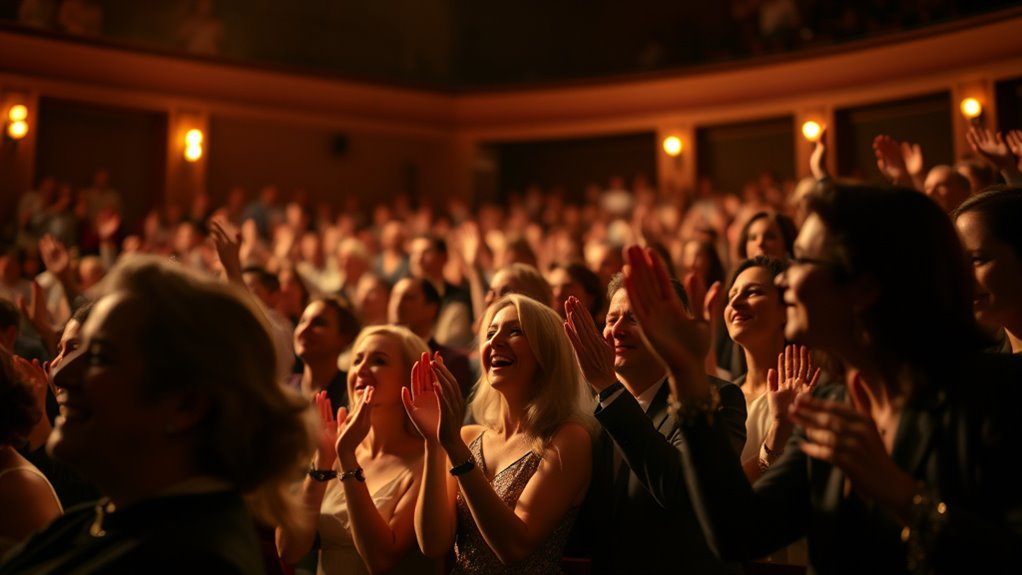Standing ovations at film premieres happen because of social dynamics and shared emotions. When you see others stand, you’re likely to follow due to social conformity and the desire for group approval. It’s a way to show appreciation, feel connected, and be part of the collective experience. Both genuine admiration and social cues motivate your participation. If you want to uncover the deeper reasons behind this social ritual, keep exploring how group behaviors influence individual choices.
Key Takeaways
- Standing ovations are driven by social conformity, where viewers mimic others to align with group norms and shared emotional experiences.
- They serve as collective affirmations, reinforcing perceptions of the film’s quality and fostering group cohesion.
- Personal motivations vary; some stand out of genuine appreciation, others to avoid social isolation or judgment.
- The act enhances emotional arousal and memorability by creating a sense of unity and acceptance among the audience.
- Visual cues and social cues influence participation, transforming spontaneous gestures into social rituals over time.

Standing ovations are more than just a sign of appreciation; they reveal fascinating insights into human psychology. When you stand up and applaud during a film premiere, you’re engaging in a complex social dynamic rooted in audience validation and social conformity. These behaviors aren’t just about expressing personal feelings—they’re influenced by the need to feel connected and accepted within a group. By standing, you’re signaling your agreement with the collective sentiment, reinforcing a shared experience that many others are also part of. This act of alignment offers validation, confirming that your opinion aligns with the group’s perception of the film’s quality. It’s a subtle but powerful way to affirm your taste and, in turn, feel more integrated into the social fabric of the event. Additionally, the physical act of standing can enhance emotional arousal, making the experience more memorable. Your decision to stand or remain seated during a standing ovation isn’t made in isolation. Instead, it’s heavily influenced by the behaviors of those around you. Social conformity plays a pivotal role here; humans have an innate tendency to mirror the actions of others, especially in public settings where judgment or social approval matters. When you see a room full of people on their feet, your instinct might be to follow suit—even if you’re unsure whether the film truly moved you to such an extent. The desire to conform can override personal hesitation, leading you to stand because everyone else is doing it. This collective movement creates a feedback loop, encouraging others to join in and reinforcing the social norm. Over time, this can transform a spontaneous gesture into an expected social ritual. Your participation in a standing ovation, then, becomes a dance between genuine emotion and social influence. While some viewers genuinely feel compelled to show their appreciation through standing, others may do so primarily to fit in or avoid standing out as the only person seated. This interplay highlights how social validation—receiving approval from others—can amplify feelings of pride and belonging. When you stand, you’re not only expressing your admiration but also signaling to the audience that you’re part of a shared emotional experience. This collective act fosters a sense of unity, making the event more memorable and meaningful. Ultimately, standing ovations serve as a fascinating example of how human psychology weaves together personal feelings with social cues, shaping behaviors in ways that reinforce community and collective approval. Recognizing the influence of wall organization and visual cues can deepen our understanding of these social rituals.
Frequently Asked Questions
How Do Cultural Differences Influence Standing Ovation Behaviors?
Cultural differences greatly influence how you behave during standing ovations. In some cultures, you follow cross-cultural etiquette by applauding enthusiastically and standing, while in others, social conformity may lead you to remain seated, respecting the group’s norms. You might feel compelled to join the crowd or prefer to stay seated based on these cultural expectations. Understanding these differences helps you navigate social situations with sensitivity and awareness.
Can Personality Traits Predict the Likelihood of Standing Ovations?
You might wonder if personality traits can predict standing ovations. While personality consistency and trait predictability vary among individuals, research suggests certain traits, like extraversion and emotionality, influence your likelihood to stand and applaud. Your consistent behaviors over time, combined with these traits, can make you more prone to spontaneous or enthusiastic reactions, including standing ovations. So, yes, personality traits do help predict your tendency to join in with the crowd.
Do Actors Influence Audience Standing Ovation Tendencies?
Imagine you’re in the crowd, feeling the buzz of excitement like a roaring ’20s speakeasy. You’re more likely to stand and cheer if the actor’s charisma sparks your enthusiasm. Actors influence audience tendencies through their presence, emotional connection, and performance. When they exude genuine passion, it boosts audience enthusiasm, making a standing ovation almost contagious. So, yes, actors profoundly impact how and when audiences decide to give that heartfelt standing ovation.
How Do Peer Pressure and Social Norms Affect Ovation Decisions?
You’re likely influenced by group conformity and social influence when deciding whether to stand or sit during an ovation. As you see others rise, you might feel compelled to follow their lead to fit in or avoid standing out. Peer pressure heightens this effect, making social norms powerful drivers in ovation decisions. Ultimately, your choice often aligns with the group’s behavior, even if your personal feelings differ.
Are There Psychological Benefits to Giving a Standing Ovation?
Think of giving a standing ovation as a double-edged sword—it’s about more than just praise. You often experience emotional release, which can lift your mood and reduce stress. Plus, it fosters social bonding, making you feel connected and part of a community. So, yes, there are psychological benefits; it boosts your well-being and strengthens relationships, turning a simple gesture into a powerful shared experience.
Conclusion
So, next time you find yourself rising to applaud, remember it’s more than just a gesture—it’s a subtle dance of emotion and social harmony. Your standing ovation gently whispers appreciation, blending personal feeling with collective warmth. It’s a quiet acknowledgment that, in this shared moment, you’re part of something greater. Embrace that delicate rhythm, and let your applause softly echo the unspoken bonds that make these cinematic moments truly unforgettable.









